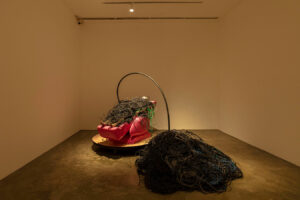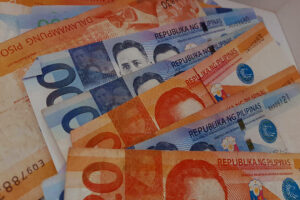By Brontë H. Lacsamana, Reporter
DESPITE having just released a book that serves as an inventory of his career that spans 50 years, Filipino artist Jose Tence Ruiz has found that there is still a lot left in the world to confront.
In a solo exhibition presented by Silverlens Manila, titled The Carbon Footprint of the Stoic Heroic, he does just that, in the form of mixed media installations, self-portraits from his earlier years, and new works on canvas.
The entire gallery space is utilized in this show, with the small gallery looking inward through varied self-portraits across the years. Meanwhile, the works in the main gallery look outward in the form of visual metaphors that use religious iconography and Mondrian’s geometric abstractions.
Mr. Ruiz’s creative practice, known to reflect contempt for the cruelties and hypocrisies of Philippine society, now spans themes of disillusionment, genocide, and the death of utopia.
The centerpiece of the exhibition, Ang Pila Balde ni Ning, Charie, Rochit, Rose, Sari, Rosie, Saring, Chayong atbp., is a baptismal font encircled by several hundred empty containers in a pointless queue for water, a carbon footprint of the entire world lining up to drink from the source of power. It is also named after people in his life who are named Rosario, or any variation of it.
At the exhibit opening on Oct. 17, gallery co-director Isa Lorenzo noted that the concept of a dried-up living rosary is yet another memorable piece in Mr. Ruiz’s storied career of works filled with social commentary.
“We’re glad he was able to realize it in this space,” she said. “That whole room of self-portraits is also something new to see.”
The small gallery shows an interesting journey — from a psychedelic drawing on paper made in his youth back in 1973, to the more depressive mixed-media Alienation Suite: Kaluluwang Kalawangin from 1976 reflecting a brief phase of depression, then Sarilarawan in 1985 depicting himself being pulled out of the torpor (represented by a carcass) as he discovered activism.
Jumping forward to 2024, Mr. Ruiz’s new painting, The Surfer, shows himself as a surfer tattooed with obligations and encumbered by Mondrian-style waves. Finally, the Ikearus installation concludes the narrative with the artist’s body modeled in resin, reclining on a massage chair and drowning under a mass of cable wires, illustrating the tragic inertia of life in the digital age.
For the artist, these last two self-portraits are a culmination of years of trying not to drown. “The nicest part is, at the end of the day, after all the struggles, I’m still going to drown — in connectedness with every shitty thing that I want to get connected to,” he said as he toured BusinessWorld around the space.
CONFRONTING THE WORLDMr. Ruiz’s paintings in the main gallery are a result of his stoicism. The Carbon Footprint of the Stoic Heroic, the painting after which the show is titled, is one of a handful there that utilize Mondrian’s visual language to symbolize the degradation of utopia in a time of genocide. It depicts a penitent lady in a bestida (dress) being embraced by a fire, becoming the embers.
The style aims to “contemporarily show debris,” he explained, like it is a structural facade broken apart. “This is the utopia of modernism that Mondrian described would work itself out in the asymmetrical equilibrium of humans, all broken apart.”
His recurring preoccupation, the reina de vestida (the queen of dressing) appears in the exhibit as well in the form of Mondrian’s Denouement: The Vestida of Carcasses. The painting depicts a lady adorned in destruction, inspired by the horrific and systematic elimination of one race by another, taking place in Gaza.
Current controversies within the Philippines also fuel Mr. Ruiz’s imagination. The painting Morion, Miron, Moron, Meron, showing the Moriones* figure with gay, erotic elements played up, came about after drag performer Pura Luka Vega faced condemnation for their drag performances involving Catholic imagery. It tackles “this saga of identity politics and conservatism,” the artist said.
Considering current political events, the title of the painting My Heart Will GUO On catches one’s attention. But it is also a visual feast — it features an image of a lifeboat hosting a Last Supper of sorts, with world leaders, archetypes of machismo, and sexual figures scrambling to occupy space on the last Titanic. “If the world is sinking, this is a situation we might find ourselves in,” said Mr. Ruiz.
This body of work which channels despair about social realities into striking visual metaphor is his “best way of putting up with the world,” he believes.
“You have to express it. You have to bring it outside of yourself, now in an aesthetic manner,” he said. “That’s the way to deal with just the complete tedium that J.D. Salinger described, that we should not accept, but that we should always dynamically engage with.”
On Oct. 26, at 1 p.m., Mr. Ruiz will host an exhibition walkthrough and book signing of his monograph Litanya: 1972-2022, published in conjunction with his exhibition last year at Ateneo Art Gallery. The Carbon Footprint of the Stoic Heroic is on view until Nov. 16 at Silverlens Manila.
Silverlens Gallery’s address is 2263 Don Chino Roces Ave. Ext., Makati.
* Moriones are traditional Holy Week characters depicted by residents of Marinduque wearing costumes replicating the garb of Roman soldiers.






